It looks like you're using an Ad Blocker.
Please white-list or disable AboveTopSecret.com in your ad-blocking tool.
Thank you.
Some features of ATS will be disabled while you continue to use an ad-blocker.
33
share:
Most of you probably remember how excited many of us were when our beloved robotic Mars explorer Opportunity, right after touching down at
Meridiani Planum back in 2004, came across some rather interesting features that later came to be known as so-called
Martian blueberries.
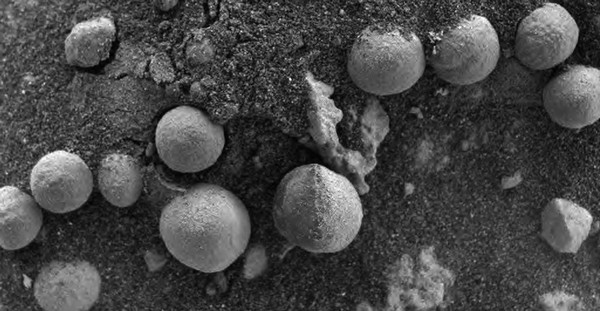 Source
Source
The excitement was not only due to the many odd spherules (aka blueberries) in that area. The geological "context" was equally intriguing and baffled scientists around the globe. After having studied these spherules for some time, it was decided that they formed in an aquaeous environment but were otherwise written off as iron-oxide bearing mineral concretions.
All hopes for these spherules being remnants of past life on Mars were shattered, but is that really the end of the story? I'm not so sure, so I decided to make this thread and revisit some of the old photographs and findings.
Organics and biology involved?
Actually, there are two Earth analogs for these spherules: the hematite concretions at Mauna Kea, Hawaii and the so-called Navaho Concretions, or Moqui Marbles, in the Glen Canyon Group in Utah. In both locations, we find iron-oxide spherules similar to the ones on Mars. In the latter case, however, microscopic analyses revealed (in some instances) morphological microstructures consistent with microorganisms.
The location in Utah, where these terrestrial spherule analogs have been found, is not unlike some of the landscapes we know from Mars:
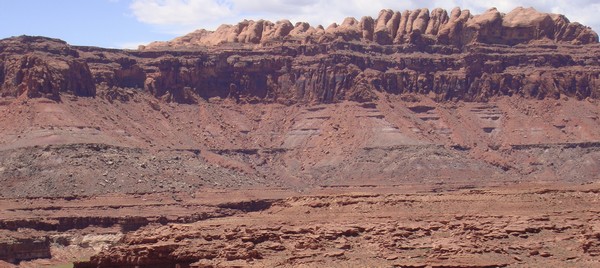 Source
Source
And here's an image of the spherules from Utah:
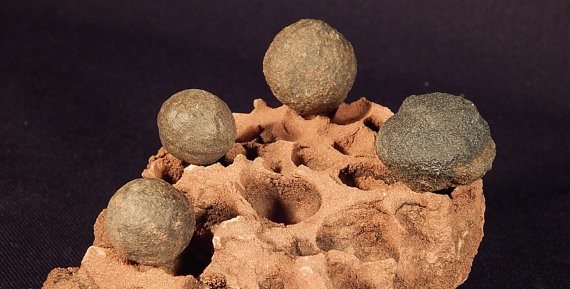 Source
Source
In a research paper dating back a few years, a group of scientists analyzed the Moqui spherules from Utah and came to some interesting conclusions:
This would indicate that microbial organisms/metabolism played a role in the formation of these spherules. But that's not the only reason why we shouldn't rule out past life on Mars just yet. Because there's another possibility: Earth fossils called Echinoderm also bear a striking similarity to the concretions found on Mars. More precisely: Echinosphaerites, an early form of ocean-dwelling crinoids that are spherical in shape and existed on Earth in the Middle Ordovician some 470 million years ago. Today's sea urchins are probably the best modern match for these ancient marine organisms.
I consider this a possibility because I noticed a few (seemingly minor) details, that might turn out to tell a different story about these spherules. Maybe they're all concretions, but there's IMO a real chance that at least some of them are something far more intriguing. In order to understand what I mean by that, we should take a closer look at the photographs that Opportunity acquired back then.
More than just mineral concretions?
Note that in the image below, quite a few of the alleged concretions seem to have a small cone or elevation on top (and this is IMO not due to the shading alone, as other spherules don't display that particular characteristic, plus it also occurs too often for it to be pure chance):
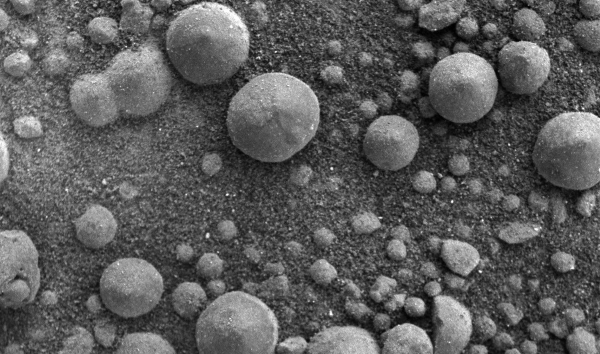 Source
Source
I highlighted only the obvious ones with yellow circles, this alone seems to be quite odd for features that are said to be random concretions. It reminds me more of a structural design, such as in RNA or DNA, but more about that later in this thread.
(...continues in second post)

The excitement was not only due to the many odd spherules (aka blueberries) in that area. The geological "context" was equally intriguing and baffled scientists around the globe. After having studied these spherules for some time, it was decided that they formed in an aquaeous environment but were otherwise written off as iron-oxide bearing mineral concretions.
All hopes for these spherules being remnants of past life on Mars were shattered, but is that really the end of the story? I'm not so sure, so I decided to make this thread and revisit some of the old photographs and findings.
Organics and biology involved?
Actually, there are two Earth analogs for these spherules: the hematite concretions at Mauna Kea, Hawaii and the so-called Navaho Concretions, or Moqui Marbles, in the Glen Canyon Group in Utah. In both locations, we find iron-oxide spherules similar to the ones on Mars. In the latter case, however, microscopic analyses revealed (in some instances) morphological microstructures consistent with microorganisms.
The location in Utah, where these terrestrial spherule analogs have been found, is not unlike some of the landscapes we know from Mars:

And here's an image of the spherules from Utah:

In a research paper dating back a few years, a group of scientists analyzed the Moqui spherules from Utah and came to some interesting conclusions:
Biosignatures Link Microorganisms to Iron Mineralization in a Paleoaquifer
In an effort to identify and verify the presence of microorganisms preserved in Fe(III) oxide concretions, we examined intergranular pore spaces along inner margins of Fe(III) oxide rinds of small (...) concretions using field emission scanning electron microscopy (FE-SEM). Microscopic analyses revealed morphological microstructures consistent with microorganisms.
This would indicate that microbial organisms/metabolism played a role in the formation of these spherules. But that's not the only reason why we shouldn't rule out past life on Mars just yet. Because there's another possibility: Earth fossils called Echinoderm also bear a striking similarity to the concretions found on Mars. More precisely: Echinosphaerites, an early form of ocean-dwelling crinoids that are spherical in shape and existed on Earth in the Middle Ordovician some 470 million years ago. Today's sea urchins are probably the best modern match for these ancient marine organisms.
I consider this a possibility because I noticed a few (seemingly minor) details, that might turn out to tell a different story about these spherules. Maybe they're all concretions, but there's IMO a real chance that at least some of them are something far more intriguing. In order to understand what I mean by that, we should take a closer look at the photographs that Opportunity acquired back then.
More than just mineral concretions?
Note that in the image below, quite a few of the alleged concretions seem to have a small cone or elevation on top (and this is IMO not due to the shading alone, as other spherules don't display that particular characteristic, plus it also occurs too often for it to be pure chance):

I highlighted only the obvious ones with yellow circles, this alone seems to be quite odd for features that are said to be random concretions. It reminds me more of a structural design, such as in RNA or DNA, but more about that later in this thread.
(...continues in second post)
edit on 10-6-2018 by jeep3r because: formatting
So what are these Echinosphaerites that we know from the terrestrial fossil record (also see catalog
here)? Well, let's have a look: The image below shows a nice collection of fossilized specimens and we can see
that they come in different sizes featuring a variety of surface textures (also note the tapered, conical top/bottom where they have not been rounded
off by erosion):
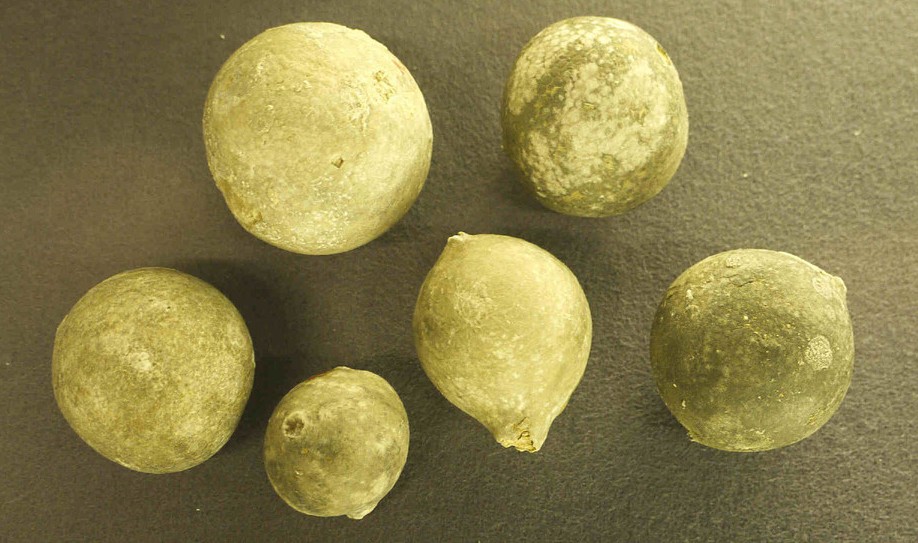
When looking closely, the variations and details seem to be strongly reminiscent of the Martian spherules. By the way, the conical features visible at both ends would be the parts that were once connected to a stem (on one end) and a kind of "mouth" (on the opposite end).
So far so good, but it gets even better. In order to shed some light on the principal anatomy of Echinosphaerites, let's have a look at the schematic diagram below - note that the stem and brachioles are usually not preserved in the fossilized specimens we know from Earth:
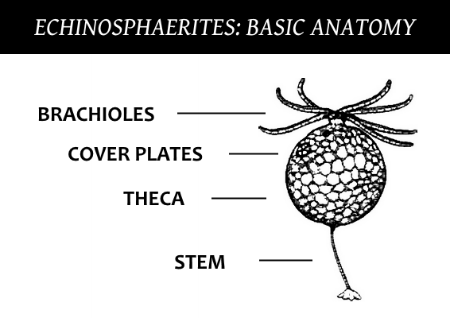
 Source 1 |
Source 2
Source 1 |
Source 2
In some fossils, where erosion has not smoothed or damaged the surface too much, we can still see a number of cover plates in the rigid skeleton encasing the body. These formed a grid of polygonal shapes (mostly pentagonal or hexagonal) making them easily identifiable as Echinosphaerite fossils. In the below example, although lacking some sharpness, the shading already provides a first hint at these potential cover plates (it will be more clear in an example further below).
 Source 1 |
Source 2
Source 1 |
Source 2
Now, some really compelling evidence (IMO) that we are here most likely dealing with fossilized "analogs" of Echinosphaerites on Mars, can be found in the 3D image below. It's one of the few cases, where a stereoscopic view of a Mars photo actually reveals the fine details that are necessary to determine that biology was likely involved. The detail in question is the polygonal/hexagonal grid around the outer core, which is typical for fossilized specimens of Echinosphaerites.
In order to see the grid, and to view the 3D image correctly, please focus on the black bar in the center then slowly cross your eyes/move eyes inward until you see a third image appear in the center (this will be the composite 3D image that your brain automatically creates from the two single images).
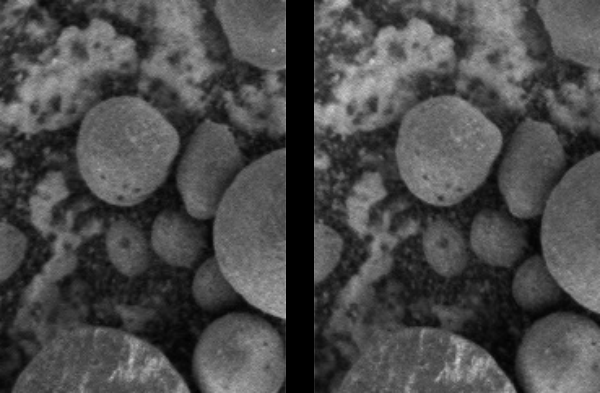 Source 1 |
Source 2
Source 1 |
Source 2
Please see here for a larger version with more context; these spherules were found at a target called "Viva La Rata" some distance away from Opportunity's landing site.
For those, who are unsure as to what they should be looking for, I created an animated image where the relevant section is highlighted (see below). And again, I only highlighted the obvious parts of the grid. When looking at the 3D image, it's quite easy to see that the features I'm referring to form an almost complete grid. And it's just one of many examples (although the best I found), where such a grid is visible.
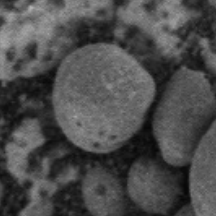
Through permineralization (pyritization), these features would have left behind iron-related traces since iron-sulfides are formed in this process.
Ultimately, I was quite surprised to find these interesting details in some of these spherules and I hope there's some potential there to kick off an interesting debate. So have at it ATS, I really look forward to your thoughts on this...
SOURCES & LINKS:
---------------------------------------------
01. Mineral in Mars 'Berries' Adds to Water Story
02. Biosignatures Link Microorganisms to Iron Mineralization (...)
03. Glad You Asked: What are Moqui marbles?
04. More information about the Ordovician period
05. GBIF: Echinosphaerites Wahlenberg, 1821
06. Old as the Hills: Echinoderms and Echinosphaerites
07. Fossilera: Polygons of Fossil Coral Heads
08. Anatomical Description of Sea Urchins
09. Polygonal Patterns in Allopolygona (Polyaxonia arrhythma)
10. Cystoid - Middle Ordovician of Northeastern Estonia
11. Earth Analog for Spectral Results From Mars Obersvations
12. NASA/JPL: Opportunity Sol 173
13. NASA/JPL: Opportunity Sol 221
14. NASA/JPL: Opportunity Sol 924
15. NASA/JPL: Opportunity Sol 1166
16. Lower Ordovician cystoids (Rhombifera, Diploporita)/Prague Basin
17. Fossil-ID: Echinosphaerites Catalog

When looking closely, the variations and details seem to be strongly reminiscent of the Martian spherules. By the way, the conical features visible at both ends would be the parts that were once connected to a stem (on one end) and a kind of "mouth" (on the opposite end).
So far so good, but it gets even better. In order to shed some light on the principal anatomy of Echinosphaerites, let's have a look at the schematic diagram below - note that the stem and brachioles are usually not preserved in the fossilized specimens we know from Earth:


In some fossils, where erosion has not smoothed or damaged the surface too much, we can still see a number of cover plates in the rigid skeleton encasing the body. These formed a grid of polygonal shapes (mostly pentagonal or hexagonal) making them easily identifiable as Echinosphaerite fossils. In the below example, although lacking some sharpness, the shading already provides a first hint at these potential cover plates (it will be more clear in an example further below).

Now, some really compelling evidence (IMO) that we are here most likely dealing with fossilized "analogs" of Echinosphaerites on Mars, can be found in the 3D image below. It's one of the few cases, where a stereoscopic view of a Mars photo actually reveals the fine details that are necessary to determine that biology was likely involved. The detail in question is the polygonal/hexagonal grid around the outer core, which is typical for fossilized specimens of Echinosphaerites.
In order to see the grid, and to view the 3D image correctly, please focus on the black bar in the center then slowly cross your eyes/move eyes inward until you see a third image appear in the center (this will be the composite 3D image that your brain automatically creates from the two single images).

Please see here for a larger version with more context; these spherules were found at a target called "Viva La Rata" some distance away from Opportunity's landing site.
For those, who are unsure as to what they should be looking for, I created an animated image where the relevant section is highlighted (see below). And again, I only highlighted the obvious parts of the grid. When looking at the 3D image, it's quite easy to see that the features I'm referring to form an almost complete grid. And it's just one of many examples (although the best I found), where such a grid is visible.

Through permineralization (pyritization), these features would have left behind iron-related traces since iron-sulfides are formed in this process.
Ultimately, I was quite surprised to find these interesting details in some of these spherules and I hope there's some potential there to kick off an interesting debate. So have at it ATS, I really look forward to your thoughts on this...
SOURCES & LINKS:
---------------------------------------------
01. Mineral in Mars 'Berries' Adds to Water Story
02. Biosignatures Link Microorganisms to Iron Mineralization (...)
03. Glad You Asked: What are Moqui marbles?
04. More information about the Ordovician period
05. GBIF: Echinosphaerites Wahlenberg, 1821
06. Old as the Hills: Echinoderms and Echinosphaerites
07. Fossilera: Polygons of Fossil Coral Heads
08. Anatomical Description of Sea Urchins
09. Polygonal Patterns in Allopolygona (Polyaxonia arrhythma)
10. Cystoid - Middle Ordovician of Northeastern Estonia
11. Earth Analog for Spectral Results From Mars Obersvations
12. NASA/JPL: Opportunity Sol 173
13. NASA/JPL: Opportunity Sol 221
14. NASA/JPL: Opportunity Sol 924
15. NASA/JPL: Opportunity Sol 1166
16. Lower Ordovician cystoids (Rhombifera, Diploporita)/Prague Basin
17. Fossil-ID: Echinosphaerites Catalog
edit on 10-6-2018 by jeep3r because: formatting
a reply to: jeep3r
Great thread jeep3r , you make a good case for a closer look at the Blueberries , it would be amusing if past life on Mars had been staring us in the face for over a decade and we didn't even realise it.
Opportunity rover , forgotten but never forgotten.
Great thread jeep3r , you make a good case for a closer look at the Blueberries , it would be amusing if past life on Mars had been staring us in the face for over a decade and we didn't even realise it.
Opportunity rover , forgotten but never forgotten.
edit on 10-6-2018 by gortex because: (no reason given)
Maybe we already have a more robust theory for these?
www.thunderbolts.info...
------------------
www.thunderbolts.info...
----------------------------
Still too early yet? Gotta stick with mainstream science? Gotta create some more dark matter and dark energy to plug the equations of cosmology that are starting to fail?
Another 10 years before we will even seriously entertain this idea? Got it.
Advocates of the Electric Universe contend that the most costly mistake in the theoretical sciences today is the ignoring of electricity. Space-age discoveries have revealed that the universe is composed almost entirely of plasma, and over a century of research into plasma has revealed its electrical properties. The refusal by the institutions of science to consider electrical explanations—even in the face of new discoveries that are predictable electrically— can only create an environment in which prior beliefs harden into dogma, and dogma inspires new waves of pseudoscience.
Could electrical arcs have created these inclusions and deposited the visible layers of soil around them? The small spheres stand out, but we also see fused globules of material where a diffuse electrical discharge lacked the intensity to create discrete spheres. Diffuse discharges are not homogeneous but consist of smaller-scale channels that vary in intensity. A regional-sized discharge that sorts and emplaces material in layers would be expected to show areas where more intense arcing formed spherules analogous to those shown in Dr. C J Ransom's laboratory experiments. In this "flash-heating" process certain minerals in the shells will be enhanced or depleted (compared to levels in the surrounding sediments). This process may also help to explain why many concretions have hollow centers, as seen in the cross section of spherules in Dr. Ransom's experiment. Trapped gases may not have time to be released before the molten surface has solidified.
www.thunderbolts.info...
------------------
In the electric view, therefore, both the domed craters and the accompanying trenches of the Arrhenius Region are the result of cosmic lightning strikes. Where an electric arc “stuck” briefly for a while to a point on the surface before being extinguished, it produced domed craters, as in Dr. Ransom’s experiments. Dr. Ransom has informed us that in his experiments, if a lower energy arc was extinguished before a complete spherule was formed, the result was a dome. The fully rounded spherules were the result of higher-energy discharges. From the Electric universe viewpoint, the domed craters and the “wormy” channels simply reflect two common electrical discharge effects on a surface. We expect to find them in close association. And we can confidently predict that more extensive laboratory experimentation will confirm the association in every important detail.
www.thunderbolts.info...
----------------------------
Still too early yet? Gotta stick with mainstream science? Gotta create some more dark matter and dark energy to plug the equations of cosmology that are starting to fail?
Another 10 years before we will even seriously entertain this idea? Got it.
originally posted by: gortex
a reply to: jeep3r
it would be amusing if past life on Mars had been staring us in the face for over a decade and we didn't even realise it.
Opportunity rover , forgotten but never forgotten.
Indeed, she just keeps rovin' and rovin'. I'm quite sure there's a lot more to discover in the image archives of Opportunity's 5000+ sols. But that kind of detective work takes time...
So, Mars was infested with rats and mice. Cool, I would feel at home there.
originally posted by: rickymouse
So, Mars was infested with rats and mice. Cool, I would feel at home there.
Well, most probably you're right. But I was thinking that the fossilized remains of a primitive, ocean-dwelling creature would be a good starting point before looking at the bigger picture.
originally posted by: muzzleflash
a reply to: jeep3r
Very good job, thank you for sharing your research. I thoroughly enjoyed reading this, it is a very compelling topic.
It's my pleasure and I know that this is the right place to post something like this. I'm glad you enjoyed the OP!
They are caused from electrical activity... This is a must watch for anyone that has not seen it..
Symbols of an Alien Sky: The Lightning Scarred Planet, Mars (Full Documentary)
Symbols of an Alien Sky: The Lightning Scarred Planet, Mars (Full Documentary)
originally posted by: ClovenSky
Maybe we already have a more robust theory for these?
Advocates of the Electric Universe contend that the most costly mistake in the theoretical sciences today is the ignoring of electricity. Space-age discoveries have revealed that the universe is composed almost entirely of plasma, and over a century of research into plasma has revealed its electrical properties. The refusal by the institutions of science to consider electrical explanations—even in the face of new discoveries that are predictable electrically— can only create an environment in which prior beliefs harden into dogma, and dogma inspires new waves of pseudoscience.
Could electrical arcs have created these inclusions and deposited the visible layers of soil around them? The small spheres stand out, but we also see fused globules of material where a diffuse electrical discharge lacked the intensity to create discrete spheres. Diffuse discharges are not homogeneous but consist of smaller-scale channels that vary in intensity. A regional-sized discharge that sorts and emplaces material in layers would be expected to show areas where more intense arcing formed spherules analogous to those shown in Dr. C J Ransom's laboratory experiments. In this "flash-heating" process certain minerals in the shells will be enhanced or depleted (compared to levels in the surrounding sediments). This process may also help to explain why many concretions have hollow centers, as seen in the cross section of spherules in Dr. Ransom's experiment. Trapped gases may not have time to be released before the molten surface has solidified.
www.thunderbolts.info...
------------------
In the electric view, therefore, both the domed craters and the accompanying trenches of the Arrhenius Region are the result of cosmic lightning strikes. Where an electric arc “stuck” briefly for a while to a point on the surface before being extinguished, it produced domed craters, as in Dr. Ransom’s experiments. Dr. Ransom has informed us that in his experiments, if a lower energy arc was extinguished before a complete spherule was formed, the result was a dome. The fully rounded spherules were the result of higher-energy discharges. From the Electric universe viewpoint, the domed craters and the “wormy” channels simply reflect two common electrical discharge effects on a surface. We expect to find them in close association. And we can confidently predict that more extensive laboratory experimentation will confirm the association in every important detail.
www.thunderbolts.info...
----------------------------
Still too early yet? Gotta stick with mainstream science? Gotta create some more dark matter and dark energy to plug the equations of cosmology that are starting to fail?
Another 10 years before we will even seriously entertain this idea? Got it.
My thoughts exactly. Too bad you’re probably right about the ten years.Thunderbolts project, David Talbott’s brainchild, was a real eye opener for me, but I imagine it is still too early for most to embrace their very solid theory. If I’m not mistaking, this subject is discussed in eiher part one of two, of the video called “symbols of an alien sky”. Worth the watch regardless.
originally posted by: CaptainBeno
a reply to: jeep3r
Dude? You're the man!
Research or what? Those two are almost identical. I'd even go as far to say absolutely spot on same?
Good work mate. Awesome.
Thanks a lot, I also think it's intriguing and really look forward to further opinions as to what this might be.
The many similarities with Echinosphaerites are quite baffling, as far as I'm concerned. Let's see if this find holds up to scrutiny.
new topics
-
'Mass Casualty event' - Attack at Christmas market in Germany
Mainstream News: 1 hours ago -
Search to Resume for MH 370
Disaster Conspiracies: 3 hours ago -
Sue Gray, Sir Keir Starmer's former Chief of Staff, Nominated for Peerage
Regional Politics: 4 hours ago -
Biden Nationalizes Another 50,000+ Student Loans as He Heads for the Exit
US Political Madness: 5 hours ago
top topics
-
'Mass Casualty event' - Attack at Christmas market in Germany
Mainstream News: 1 hours ago, 15 flags -
An Interesting Conversation with ChatGPT
Science & Technology: 15 hours ago, 8 flags -
Biden Nationalizes Another 50,000+ Student Loans as He Heads for the Exit
US Political Madness: 5 hours ago, 7 flags -
Sue Gray, Sir Keir Starmer's former Chief of Staff, Nominated for Peerage
Regional Politics: 4 hours ago, 2 flags -
Search to Resume for MH 370
Disaster Conspiracies: 3 hours ago, 2 flags
active topics
-
'Mass Casualty event' - Attack at Christmas market in Germany
Mainstream News • 14 • : NorthOS -
Can someone 'splain me like I'm 5. Blockchain?
Science & Technology • 90 • : Ravenwatcher -
Russias War Against Religion in Ukraine
World War Three • 54 • : andy06shake -
Search to Resume for MH 370
Disaster Conspiracies • 3 • : chr0naut -
Drone Shooting Arrest - Walmart Involved
Mainstream News • 36 • : imitator -
-@TH3WH17ERABB17- -Q- ---TIME TO SHOW THE WORLD--- -Part- --44--
Dissecting Disinformation • 3768 • : Thoughtful3 -
Have you noticed?? Post Election news coverage...
World War Three • 10 • : chr0naut -
An Interesting Conversation with ChatGPT
Science & Technology • 21 • : Flyingclaydisk -
US Federal Funding set to Expire December 20th. Massive CR on the way.
Mainstream News • 45 • : marg6043 -
Biden Nationalizes Another 50,000+ Student Loans as He Heads for the Exit
US Political Madness • 5 • : Dalamax
33
